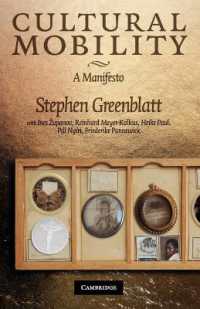- ホーム
- > 洋書
- > 英文書
- > Science / Mathematics
Full Description
In the 1950s, John Reber convinced many Californians that the best way to solve the state's water shortage problem was to dam up the San Francisco Bay. Against massive political pressure, Reber's opponents persuaded lawmakers that doing so would lead to disaster. They did this not by empirical measurement alone, but also through the construction of a model. Simulation and Similarity explains why this was a good strategy while simultaneously providing an account of modeling and idealization in modern scientific practice. Michael Weisberg focuses on concrete, mathematical, and computational models in his consideration of the nature of models, the practice of modeling, and nature of the relationship between models and real-world phenomena.
In addition to a careful analysis of physical, computational, and mathematical models, Simulation and Similarity offers a novel account of the model/world relationship. Breaking with the dominant tradition, which favors the analysis of this relation through logical notions such as isomorphism, Weisberg instead presents a similarity-based account called weighted feature matching. This account is developed with an eye to understanding how modeling is actually practiced. Consequently, it takes into account the ways in which scientists' theoretical goals shape both the applications and the analyses of their models.
Contents
Contents ; Preface ; 1 Introduction ; 1.1 Two Aquatic Puzzles ; 1.2 Models of Modeling ; 2 Three Kinds of Models ; 2.1 Concrete Model: The San Francisco Bay-Delta Model ; 2.2 Mathematical Model: Lotka-Volterra Model ; 2.3 Computational Model: Schelling's Segregation Model ; 2.4 Common Features of these Models ; 2.5 Only Three Types of Models? ; 2.6 Fewer Than Three Types of Model? ; 3 The Anatomy of Models: Structure & Construal ; 3.1 Structure ; 3.1.1 Concrete Structures ; 3.1.2 Mathematical ; 3.1.3 Computational ; 3.2 Model Descriptions ; 3.3 Construal ; 3.4 Representational Capacity of Structures ; 4 Fictions and Folk Ontology ; 4.1 Against Maths: Individuation, Causes, and Face Value Practice ; 4.2 A Simple Fictions Account ; 4.3 Enriching the Simple Account ; 4.3.1 Waltonian Fictionalism ; 4.3.2 Fictions without Models ; 4.4 Why I am not a Fictionalist ; 4.4.1 Variation ; 4.4.2 Representational Capacity of Different Models ; 4.4.3 Making Sense of Modeling ; 4.4.4 Variation in Practice ; 4.5 Folk ontology ; 4.6 Maths, Interpretation, and Folk Ontology ; 5 Target Directed Modeling ; 5.1 Model Development ; 5.2 Analysis of the Model ; 5.2.1 Complete Analysis ; 5.2.2 Goal-directed Analysis ; 5.3 Model/Target Comparison ; 5.3.1 Phenomena and Target Systems ; 5.3.2 Establishing the fit between Model and Target ; 5.3.3 Representations of Targets ; 6 Idealization ; 6.1 Three Kinds of Idealization ; 6.1.1 Galilean idealization ; 6.1.2 Minimalist idealization ; 6.1.3 Multiple Models Idealization ; 6.2 Representational Ideals and Fidelity Criteria ; 6.2.1 Completeness ; 6.2.2 Simplicity ; 6.2.3 1-Causal ; 6.2.4 Maxout ; 6.2.5 P-General ; 6.3 Idealization and Representational Ideals ; 6.4 Idealization and Target Directed Modeling ; 7 Modeling Without a Specific Target ; 7.1 Generalized Modeling ; 7.1.1 How Possibly Explanations ; 7.1.2 Minimal Models and First Order Causal Structures ; 7.2 Hypothetical Modeling ; 7.2.1 Contingent Non-existence: xDNA ; 7.2.2 Impossible Targets: Infinite Population Growth and Perpetual Motion ; 7.3 Targetless Modeling ; 7.4 A Moving Target: The Case of Three-sex Biology ; 8 An Account of Similarity ; 8.1 Desiderata for Model/World Relations ; 8.2 Model Theoretic Accounts ; 8.3 Similarity ; 8.4 Tversky's Contrast Account ; 8.5 Attributes and Mechanisms ; 8.6 Feature Sets, Construals, and Target Systems ; 8.7 Modeling Goals and Weighting Parameters ; 8.8 Weighting Function and Background Theory ; 8.9 Satisfying the Desiderata ; 9 Robustness Analysis and Idealization ; 9.1 Levins and Wimsatt on Robustness ; 9.2 Finding Robust Theorems ; 9.3 Three Kinds of Robustness ; 9.3.1 Parameter Robustness ; 9.3.2 Structural Robustness ; 9.3.3 Representational Robustness ; 9.4 Robustness and Confirmation ; 10 Conclusion: The Practice of Modeling ; References








